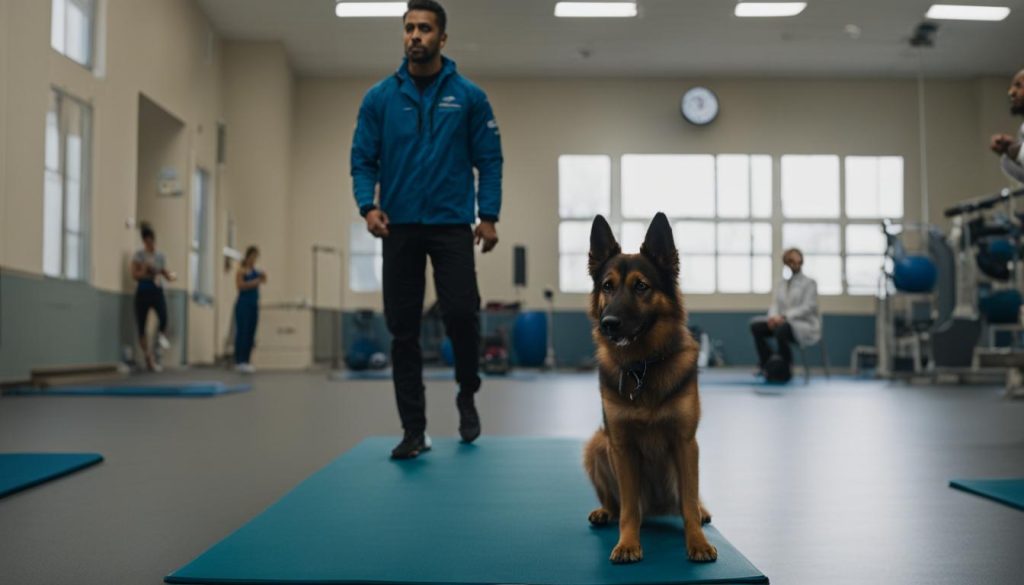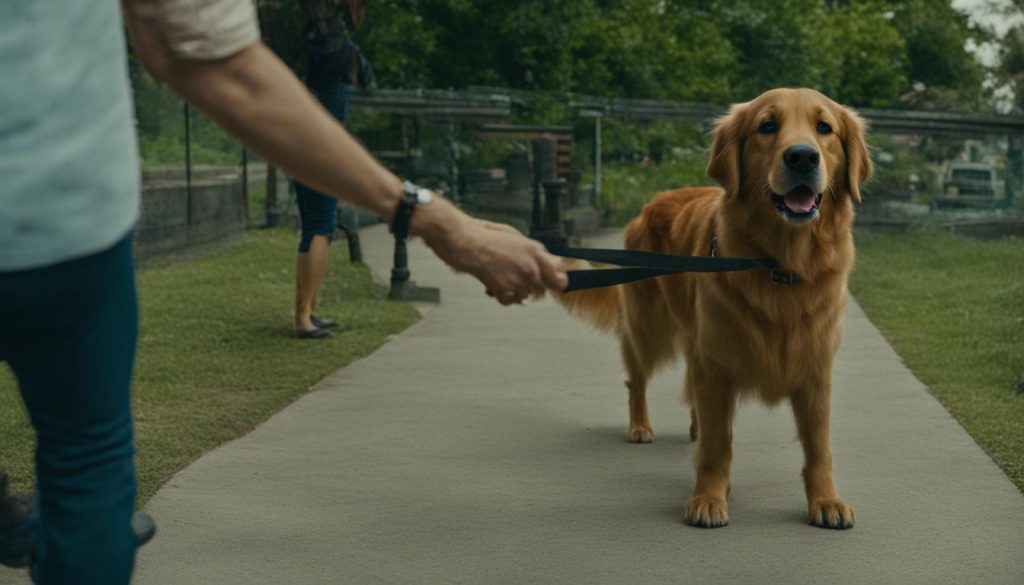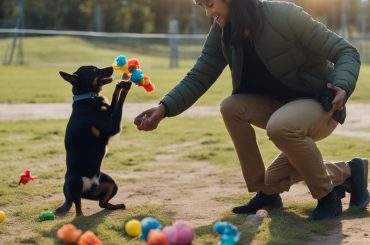Teaching a dog to stay is an essential skill for their safety and obedience. It helps prevent them from running off or getting into dangerous situations.
Before diving into the steps, let me introduce myself. I’m a professional dog trainer with years of experience in obedience training.
Key Takeaways:
- Teaching stay is crucial for your dog’s safety and behavior.
- Establish a foundation of basic obedience commands before teaching stay.
- Follow the 6-step guide to effectively teach your dog to stay.
- Use these extra tips to enhance your stay training sessions.
- Create clear cues for the beginning and ending of the stay command.
The Importance of Teaching Stay
When it comes to dog behavior training, teaching your furry friend to stay is an essential skill. Not only does it help keep them safe from potential dangers, but it also contributes to their overall obedience and behavior. By mastering the stay command, your dog will learn to listen and follow instructions, making them a well-behaved pet.
One of the key benefits of teaching stay is that it prevents dogs from wandering off or running into traffic. By having your dog stay in one place, you can ensure their safety and provide them with a controlled environment. Additionally, teaching stay enhances your dog’s focus and impulse control, helping them become better-behaved both at home and in public settings. It also lays the foundation for more advanced training exercises.
“Teaching a dog to stay is crucial for their safety and behavior. It helps prevent them from running off or getting into dangerous situations. It also enhances their obedience and overall training, making them a well-behaved pet.”
There are various stay training techniques that can be used to teach your dog this important command. These techniques typically involve a combination of verbal cues, hand signals, and positive reinforcement. By using consistent signals and rewards, you can effectively communicate your expectations to your dog and encourage them to stay in a given position.
| Benefits of Teaching Stay | Stay Training Techniques |
|---|---|
| 1. Ensures safety by preventing dogs from running off or getting into dangerous situations. | 1. Use consistent verbal cues and hand signals to communicate your expectations. |
| 2. Enhances overall obedience and behavior, making your dog a well-behaved pet. | 2. Use positive reinforcement, such as treats or praise, to reward your dog for staying. |
| 3. Builds focus and impulse control, improving your dog’s behavior at home and in public. | 3. Practice in different environments to help generalize the stay command. |
To summarize, teaching your dog to stay is an important aspect of their training and behavior. It not only ensures their safety but also contributes to their overall obedience and well-being. By using effective stay training techniques and providing consistent reinforcement, you can successfully teach your dog to stay in different situations and create a harmonious bond between you and your furry companion.
Establishing a Foundation

Before diving into teaching your dog to stay, it’s important to establish a solid foundation of basic obedience commands. Teaching your dog commands like sit and lie down not only creates a well-behaved pet but also makes it easier for them to understand and follow the stay command. By ensuring your dog has a good grasp of these basic commands, you set them up for success in learning more complex behaviors like stay.
To begin, make sure your dog is familiar with commands such as sit and lie down. Spend time practicing these commands in a calm and distraction-free environment. Use positive reinforcement techniques, such as treats and praise, to reward your dog when they successfully follow the commands. This will help strengthen their understanding and responsiveness.
Once your dog is comfortable and reliable with sit and lie down, you can introduce the stay command. Remember to be patient and consistent during the training process. Dogs may take some time to grasp new commands and behaviors, but with practice and positive reinforcement, they will eventually learn to stay on command.
By establishing a foundation of basic obedience commands, you create a strong base for teaching your dog to stay. This will make the training process smoother and more effective, leading to a well-behaved and obedient pet.
The Six-Step Guide to Teaching Stay

To effectively teach your dog to stay, follow these six steps:
Step 1: Ask your dog to lie down.
Start by giving the command for your dog to lie down. This is the starting position for teaching the stay command.
Step 2: Give a hand signal to indicate stay.
In addition to the verbal command, introduce a hand signal to signify the stay command. A stop sign gesture works well for this purpose.
Step 3: Wait a few seconds before giving a treat and saying “stay.”
Once your dog is in the lying down position and you’ve given the hand signal for stay, wait a few seconds before rewarding them with a treat and saying “stay.” This reinforces the behavior of staying in place.
Step 4: Practice in short sessions and gradually increase the duration of the stay.
Start with short training sessions and gradually increase the duration of the stay command. Begin with a few seconds and gradually work your way up to a minute or more. Consistent practice will help your dog understand and improve their stay skills.
Step 5: Start increasing the distance between you and your dog while they stay.
Once your dog is comfortable staying in place for longer durations, start increasing the distance between you and your dog. This helps them understand that the stay command should be followed regardless of your proximity.
Step 6: Practice in different environments to generalize the stay command.
Finally, it’s important to practice the stay command in different environments to generalize the behavior. Take your dog to different locations and practice the stay command to ensure they understand the command in different settings.
By following these six steps and practicing consistently, you can successfully teach your dog to stay in various situations. Remember to be patient and provide positive reinforcement to encourage your dog’s progress.
Extra Tips for Stay Training
When teaching your dog to stay, it’s important to have some additional tips and tricks up your sleeve. These guidelines will help you ensure that your dog becomes a pro at staying put in different situations.
Consistency is Key
Consistency is crucial in stay training. Use the same verbal cue, hand signal, and release word every time you practice the stay command. This will help your dog understand and remember what is expected of them.
Gradually Extend the Duration
Start with short durations and gradually increase the time your dog needs to stay. Begin with just a few seconds and then work your way up to a minute or longer. Remember to always reward your dog before they break the stay to reinforce the behavior.
Practice in Different Environments
Teach your dog to stay in various locations such as your backyard, the park, or even inside your house. By practicing in different environments, your dog will learn to generalize the stay command and will be able to obey the command wherever you are.
With these extra tips in mind, you’ll be well-equipped to effectively teach your dog to stay. Remember to stay patient and consistent throughout the training process, and soon enough, your furry friend will become a stay champion!
| Stay Training Tips | |
|---|---|
| 1. | Be consistent with verbal cues and hand signals. |
| 2. | Gradually increase the duration of the stay. |
| 3. | Practice in different environments to generalize the behavior. |
Creating a Definite Beginning and Ending

When teaching your dog to stay, it’s essential to have clear cues for the beginning and ending of the stay command. These cues will help your dog understand when to stay and when they can move. Consistency in using these cues is key to successful stay training.
Defining the Release Word
To signal the end of the stay command, use a release word like “OK” or “Free.” This release word should be distinct and not commonly used in everyday conversations with your dog. By consistently using the same release word, your dog will become familiar with it and understand that they can move from their stay position.
Introducing the Release Word
When starting stay training, use the release word immediately after your dog successfully completes the stay command. For example, say “stay” and give the hand signal, then wait a few seconds before saying the release word and offering praise or a reward. This introduces the concept of the release word and reinforces its association with the end of the stay command.
“Using a release word in stay training is crucial for setting clear boundaries and ensuring your dog knows when they can move. Consistency in using the same release word will help your dog understand the command and enhance their overall obedience.”
— Dog Training Expert
Remember to always use the release word when ending the stay command, even during everyday situations such as when opening doors or welcoming guests. This consistency will reinforce the concept and help your dog stay focused and obedient.
The Three D’s: Duration, Distance, and Distractions
To enhance your dog’s stay training and ensure their obedience in various situations, it’s essential to focus on the three D’s – duration, distance, and distractions. By gradually increasing these factors, you can challenge your dog’s ability to maintain the stay command and stay focused.
Duration:
Start with short durations of stay and gradually increase the time your dog must hold the position. Begin by asking your dog to stay for just a few seconds and reward them for their success. As they become more comfortable and reliable, extend the duration gradually. Remember to reward your dog before they break the stay to reinforce the behavior.
Distance:
Once your dog understands the stay command and can hold it for longer durations, you can start increasing the distance between you and your dog. Begin by taking a small step back and gradually increase the distance as your dog becomes more proficient. Reward your dog for staying in place, even when you are farther away.
Distractions:
Introducing distractions during stay training is crucial for real-life scenarios. Start by adding mild distractions, such as toys or treats scattered nearby, and gradually increase the level of distractions. This could include people walking by, other animals, or noises. Practice in different environments to ensure your dog can stay focused and maintain the stay command, regardless of the distractions present.
By focusing on duration, distance, and distractions, you can advance your dog’s stay training and ensure their obedience in various situations. Remember to remain patient and consistent throughout the training process. With practice and positive reinforcement, your dog will become proficient in staying in place, enhancing their overall obedience and safety.
Proofing the Stay Command
Once your dog has learned the basics of the stay command, it’s important to proof their understanding and reliability in different situations. Proofing the stay command involves gradually increasing the duration, distance, and distractions while ensuring your dog stays focused and obedient.
Begin by extending the duration of the stay. Start with short durations and gradually increase the time your dog is expected to stay in place. This helps build their ability to remain calm and patient in various scenarios.
Next, work on increasing the distance between you and your dog while they stay. Start by taking small steps away from them and gradually increase the distance. This helps them understand that the stay command applies even when you’re not in close proximity.
In addition to duration and distance, it’s crucial to introduce distractions during stay training. Start with minor distractions and gradually add more challenging stimuli. This could include noises, toys, or even other animals. By exposing your dog to distractions, you’ll prepare them to stay focused even in distracting environments.
Tips for Successful Proofing
Here are some tips to ensure successful proofing of the stay command:
- Be patient and consistent. Keep in mind that proofing takes time and repetition.
- Start proofing in a controlled environment before progressing to more challenging settings.
- Gradually increase the difficulty level of distractions to ensure steady progress.
- Reward your dog for staying focused and obedient in the presence of distractions.
Remember, proofing the stay command is essential to ensure your dog’s reliability in different situations. By following these tips and practicing regularly, you’ll have a well-trained dog that can stay calm, focused, and obedient, no matter the distractions.
| Stay Training Tips | Teaching Stay to Dogs |
|---|---|
| Extend the duration of the stay gradually | Start with short durations and gradually increase the time |
| Increase the distance between you and your dog while they stay | Take small steps away and gradually increase the distance |
| Introduce distractions during stay training | Start with minor distractions and gradually add more challenging stimuli |
| Be patient, consistent, and reward your dog’s progress | Remember that proofing takes time and repetition |
Things to Avoid in Stay Training
When it comes to teaching your pet to stay, there are certain common pitfalls that you should avoid. By being aware of these mistakes, you can ensure a more effective and successful training process.
1. Using Food as a Lure
While treats can be useful for motivating your dog during training, relying too heavily on food as a lure for the stay command can create dependency. The goal is to have your dog stay based on the command alone, rather than the expectation of a treat. Gradually reduce the frequency of treat rewards and transition to intermittent reinforcement to reinforce the behavior.
2. Always Calling Your Dog Out of a Stay
One mistake that many dog owners make is constantly calling their dog out of a stay position. This can create confusion for your pet and undermine the training progress. Instead, focus on using a release word like “OK” or “Free” to signal the end of the stay. This clear cue will help your dog understand when they can move and when they should stay.
3. Expecting Them to Stay for Long Periods
When starting the stay training, it’s important to set realistic expectations for the duration of the stay. Asking your dog to stay for long periods right from the beginning can lead to frustration and a lack of progress. Start with short durations and gradually increase the time as your dog becomes more comfortable and reliable with the stay command.
Avoiding these pitfalls and focusing on positive reinforcement, consistency, and setting your dog up for success will help you achieve the desired results in stay training. Remember to be patient and consistent with your approach, and your dog will soon master the stay command.
Wrapping Up
To summarize, teaching a dog to stay is an essential part of dog training. By following the right techniques and practicing regularly, you can successfully teach your dog to stay in various situations, ensuring their safety and obedience.
Remember to establish a foundation of basic obedience commands before starting stay training. This will make it easier for your dog to understand and follow the stay command.
Use the six-step guide to teaching stay, gradually increasing the duration, distance, and distractions to advance your dog’s training. Consistency, positive reinforcement, and setting your dog up for success are key to a successful stay command.
By proofing the stay command and practicing in different environments, you can ensure that your dog stays reliably in any situation. Avoid common pitfalls and focus on positive reinforcement, consistency, and patience to achieve the best results in teaching your dog to stay.
FAQ
Is teaching a dog to stay important?
Yes, teaching a dog to stay is crucial for their safety and behavior. It helps prevent them from running off or getting into dangerous situations. It also enhances their obedience and overall training, making them a well-behaved pet.
What should I do before teaching my dog to stay?
Before starting to teach stay, it’s important to establish a foundation of basic obedience commands like sit and lie down. This will make it easier for your dog to understand and follow the stay command.
How do I teach my dog to stay?
Follow these steps to teach your dog to stay:
– Ask your dog to lie down.
– Give a hand signal (such as a stop sign) to indicate stay.
– Wait a few seconds before giving a treat and saying “stay.”
– Practice in short sessions and gradually increase the duration of the stay.
– Start increasing the distance between you and your dog while they stay.
– Practice in different environments to generalize the stay command.
Any additional tips for stay training?
Here are some additional tips for successful stay training:
– Gradually extend the duration of the stay.
– Reward your dog before they break the stay to set them up for success.
– You can also teach stay in a sitting position by following the same steps.
– Practice in various locations to ensure your dog can stay in different settings.
How do I create a definite beginning and ending for the stay command?
It’s important to have clear cues for the beginning and ending of the stay command. Use a release word like “OK” or “Free” to signal that the stay is done. Consistency in these cues will help your dog understand when to stay and when they can move.
What are the three D’s in stay training?
The three D’s in stay training are duration, distance, and distractions. As you advance your dog’s stay training, gradually increase the duration of the stay, the distance between you and your dog, and introduce distractions to test their ability to stay focused.
How do I proof the stay command?
Proofing the stay command is essential to ensure your dog can stay in different situations. Work on increasing the duration, distance, and distractions while maintaining reliability. Also, practice the stay command in various environments to generalize the behavior.
What should I avoid in stay training?
Avoid common pitfalls in stay training, such as using food as a lure, always calling your dog out of a stay, and expecting them to stay for long periods. Focus on positive reinforcement, consistency, and setting your dog up for success.
How can I effectively teach my dog to stay?
By following the right techniques and practicing regularly, you can successfully teach your dog to stay in various situations, ensuring their safety and obedience.






